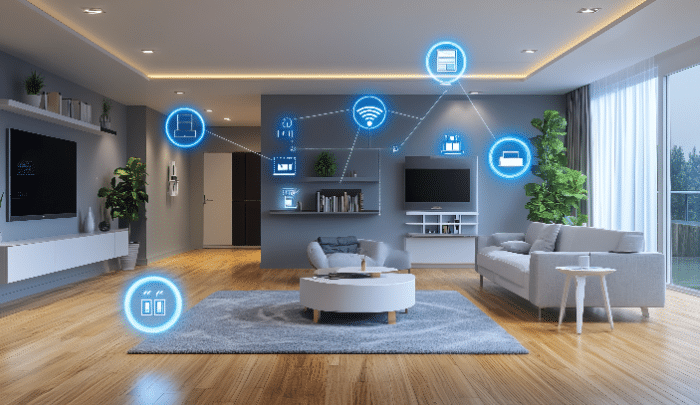How Smart Home Technology Enhances Modern Living Spaces
Integrating Technology for a Smarter Safer Lifestyle
Are you curious how everyday gadgets can transform your home into a clever, efficient sanctuary? Have you ever wondered whether the hype around “smart home technology” is worth the fuss? Perhaps you’ve heard neighbors or family rave about controlling everything from lights to security cameras through a single app.
In our increasingly digital world, these systems are becoming more common, and for good reason. They can cut energy bills, simplify daily routines, and provide peace of mind. This blog post will walk you through everything you need to know, from basic setups to the latest tech trends, so you can decide where to begin (or expand) your smart home journey.
How Does a Smart Homework?
A smart homework by linking devices—like lights, speakers, or cameras—to a central hub or a series of apps. This network often relies on Wi-Fi, but more advanced systems might use dedicated communication protocols like Zigbee or Z-Wave. In practice, you use your smartphone or a voice assistant (such as Amazon Alexa or Google Assistant) to interact with these gadgets.
Even something as simple as a connected door lock can show you the potential convenience. Instead of rummaging for keys, you can unlock or lock the door with a quick tap in an app. You can even set up routines where certain actions happen automatically, such as lights turning on at sunset.
Simple Starter Devices and Entry-Level Solutions
When beginning a smart home setup, start small. You might opt for a smart speaker, like a Google Nest Mini or Amazon Echo, to control music, news, or playlists around the house using only your voice. Another great beginner step is a pack of smart bulbs, so you can change lighting modes, adjust brightness, or even switch on your lights as you pull into the driveway. Many Aussies also find a Wi-Fi plug helpful for turning off devices draining power. It’s easy to install, usually just requiring you to plug it into a socket and then pair it with your home’s Wi-Fi.
Tips for Smooth Integration
For seamless integration, focus on brands that play nicely with each other. You don’t want to juggle multiple apps if you can avoid it. If a device works with Google Home or Apple HomeKit, pick most of your devices under that ecosystem. Try not to buy random gadgets on impulse—plan so each device can talk to one another effectively. Lastly, place your router in a central spot to guarantee a strong Wi-Fi signal. If you have a larger home, consider a mesh network to keep everything running smoothly.
Which Smart Home Devices Are Most Common in Australia?
In Australia, smart lighting is huge. There’s a wide range of LED bulbs and strip lights that you can control via apps or voice assistants. Thanks to their versatility, smart speakers, such as Google Nest or Amazon Echo, also appear in countless homes. Security systems, from doorbells with built-in cameras to web-connected CCTV units, are seeing growing interest. People want to keep an eye on their properties, and the ability to monitor it all through a smartphone is a strong selling point.
Smart Lighting, Speakers, and Security Systems
Smart lighting sets the mood at dinner, brightens a home office, and conserves energy by minimizing wasted power. Voice-activated speakers offer everything from daily news updates to on-demand jokes while helping you schedule meetings or control other connected devices. On the other hand, modern security systems can include cameras that send alerts when a parcel arrives. Some security apps even let you chat with the courier in real-time, which is fantastic for anyone who’s often out and about.
Installation Considerations and Ongoing Maintenance
Essential smart lights, speakers, and cameras are usually simple to install. More complex items, like a sensor-based security system, require professional installation to ensure everything is set up accurately. Maintenance is straightforward—most devices only need regular software updates and an occasional reset. Changing batteries in wireless sensors can be an extra step, so keep an eye on battery indicators. Regularly review your app’s settings to confirm that everything is up-to-date and secure.
Upgrading Existing Homes
You don’t need to build a fancy new house to reap the benefits of innovative technology. A heritage-listed bungalow or a weatherboard home in regional Australia can be modernized. Quick-win projects often involve lower-cost devices that deliver fast returns, such as motion-detecting lights or smart thermostats. Let’s tackle a few common questions and highlight affordable ways to get started.
How Can I Convert My Traditional Home into a Smart Home?
Converting a traditional home into a smart haven is usually easier than people imagine. Begin by upgrading light switches to smart-friendly options or installing a Wi-Fi-enabled thermostat to fine-tune temperature settings. You could also automate your existing curtains with motorized rods or add a smart lock to your front door. A key first step is ensuring your internet is stable, and you have enough coverage throughout the house. Pick devices that solve your biggest pain points, such as security or energy efficiency.
Cost-Effective Upgrades for Immediate Impact
Smart plugs, app-controlled lights, and basic leak sensors are all wallet-friendly. If you want something more advanced, consider a voice-activated hub that syncs your TV, lights, and air conditioning. Another cost-effective solution is a multi-room audio setup: place smart speakers in different areas to enjoy music everywhere or create a quick communication system across the home. These are smaller investments that deliver plenty of convenience straight away.
Quick Solutions for Improved Comfort
A simple upgrade is installing motion-sensor lights in bathroom renovations or hallways. They’re convenient late at night and can save on electricity costs. A centralized app to control your blinds can also make your mornings smoother—just schedule them to open at sunrise. If you want more control over indoor temperature without redecorating, a smart heating and cooling controller might be the answer. It can work with some older air conditioning units, letting you set timers, create cooling schedules, and adjust settings from your smartphone.
Ensuring Usability for Families and Guests
A house is rarely a one-person affair. You might have housemates, kids, or visiting relatives who must adapt to the smart system. To keep things user-friendly, create shared voice commands or short app tutorials so everyone can turn off the lights or adjust the bedroom temperature. You could also set up additional user accounts on your primary home app so different family members can access certain features without messing with intricate settings.
Tackling Technical Hurdles and Compatibility Issues
Before making any big purchase, double-check brand compatibility. For example, if you’ve already chosen Google Home as your main hub, buy sensors, speakers, and switches that are “Works with Google Home” certified. If you mix ecosystems (like Apple HomeKit and Amazon Alexa), you could face extra steps converting commands or linking services. Finally, don’t forget about firmware updates—most brands release them to fix bugs and introduce new features. Installing updates keeps your system running smoothly and less prone to connectivity glitches.
Finding the Right Service Providers and Packages
When you’re ready for a bigger commitment—like a comprehensive home automation system covering climate control, blinds, CCTV, and more—it might be best to consult a professional installer. Search for local businesses or national providers that offer integrated packages. They’ll often assess your home’s layout, recommend compatible brands, and give you a projected timeline. It requires a bigger budget, but the convenience and worry-free setup can be worth it.
Privacy, Data Protection, and Cybersecurity
One important step is reading the privacy policies of your chosen brands. Most major tech companies encrypt data, but you should still be mindful of how your device’s microphone or camera is used. If you’re uneasy about voice assistants recording conversations, you can disable certain features or mute the microphone. As with any technology, staying informed and updated helps maintain your privacy and peace of mind.
Troubleshooting and Technical Support
One advantage of working with reputable brands is the availability of support. Many companies offer detailed online guides, community forums, or 24/7 helplines. If an app crashes or your device won’t respond, these resources can swiftly guide you to a fix. Keep track of receipts and warranties, too. If you face a hardware fault, having everything in one place for swift replacements or repairs is helpful.
Conclusion
Smart homes have evolved from tech enthusiast fantasies to accessible realities for everyday Australians. The convenience of controlling lights, appliances, and security from a single interface can drastically transform how you manage tasks and errands. Beyond saving time, tracking and optimizing energy use helps your budget and the environment.
Ultimately, adopting smart home technology allows you to shape a living space that’s truly your own. Take it step by step—pick one or two devices first, then build your system as your needs and interests grow. You’ll discover that smart living doesn’t have to be intimidating. It can become one of the most rewarding, stress-relieving upgrades you’ll ever introduce to your household. By staying informed, planning carefully, and investing wisely, you’ll harness the full potential of a connected home and create an environment that’s comfortable, efficient, and ready for the future.






